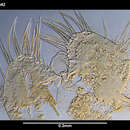en
names in breadcrumbs


“Spinacopia, new genus
TYPE-SPECIES — Spinacopia sandersi Kornicker, described herein.
ETYMOLOGY — The generic name "Spinacopia," from the Latin "spina" = thorn and "copia" = abundance. Gender: feminine.
DIAGNOSIS OF GENUS.—Shape: Carapace oval with greatest height near middle in female and posterior to middle in male; shallow incisur present on both male and female; rostrum of male more prominent than on female.
Ornamentation: Punctate or smooth and with abundant hairs and scattered normal pores.
Infold: Infold of female characterized by having 5 stout spinous bristles forming row in front of caudal process (6 bristles observed on single valve of 1 specimen); 3-8 smaller spinous bristles present below larger bristles; infold in front of caudal process of single male observed with only 4 large spinous bristles and 2 or 3 smaller bristles; both female and male with single bristle below rostrum.
Size: Length of mature females of 4 species ranges from 1.71 to 2.75 mm; height as percent of length ranges from 80.2 to 94.1. Male slightly smaller and much narrower than female; height as percent of length 69.4.
First antenna: Second joint with 1 dorsal bristle, 3rd joint with usual ventral and dorsal bristles; 4th joint with 1 dorsal and 2 or 3 ventral bristles; sensory bristle of 5th joint on both male and female normal for family; medial bristle of 6th joint of female minute and missing on some specimens, same bristle longer on male; bristles of joints 7 and 8 normal for family.
Second antenna: Protopodite without medial bristle; expodite normal for family, with 2 bristles on 9th joint; endopodite of female 2-jointed with 2 or 3 bristles on 1st joint and 1 (rarely 2) long bristle on 2nd joint; endopodite of male (S. sandersi) 3-jointed with 3rd joint recurved: 1st joint with 2 bristles, 2nd with 3, 4th with 2.
Mandible: Considerable sexual dimorphism usually present in family; coxale endite with bifurcate tip present in female, absent in male; ventral margin of coxale on female fringed with hairs; basale of female with 1 spine near middle of dorsal margin and 2 distally, ventral margin with total of 8 or 9 spines and bristles; exopodite of both male and female prominent and with bristle reaching one-fourth to one-third the length of 1st endopodite joint; basale of male (S. sandersi) with 3 bristles on dorsal margin and 7 short bristles and 1 extremely long bristle on ventral margin. Endopodite of male: 1st joint with 1 long and 2 short distoventral bristles; 2nd joint with 2 stout bristles near middle of dorsal margin and 1 long and 1 medium bristle on terminal end near ventral margin; 3rd joint with short a-bristle, stout clawlike b-bristle, short clawlike c-bristle, and long d-bristle. Endopodite of female: joints 1-3 with large claws normal for family; joint 1 with 2 medial spines at base of main claw and 1 distodorsal spine; joint 2 with 2 dorsal spines and 1 lateral spine at base of main claw; joint 3 with 2 ventral spines and 1 small spine medially near base of main claw.
Maxilla: Normal for family. Exopodite with 3 bristles.
Fifth limb: Endite with 1 bristle; 1st joint with 3 bristles; 2nd joint with 6 bristles; 3rd joint with 1 (rarely 2) bristle on outer lobe and 3 or 4 bristles on inner lobe; 4th and 5th joints with 4-6 bristles.
Sixth limb: All species in the genus with at least 3 distinct endites; in 3 species, S. menziesi, S. variabilis, and S. bisetula, 4 endites evident, but in S. sandersi the 4th endite not separated from end joint by indentation in margin. First endite with 1-3 bristles; 2nd endite with 2 or 3 bristles; 3rd endite with 3 or 4 bristles; 4th endite with 3-5 bristles; end joint with 2-4 (rarely 5) anterior bristles, 1 or 2 (rarely 3) middle bristles, and 1-3 hirsute posterior bristles.
Seventh limb: Well developed in both male and female; proximal group with 4-10 bristles; distal group with 6 bristles, 3 on each side; each bristle spinous distally; terminus with opposing combs; each comb with 9-12 teeth in female and 2 or 3 in male.
Furca: Each lamella with 7 or 8 claws; claw 3 shorter than claw 4; claw 1 continuous with lamella.
Eyes: Lateral eyes absent. Medial eye large. (Lateral eyes are generally present in sarsiellids, most of which have been reported from shallow water.)
Rod-shaped organ: 1 - or 2-jointed and with rounded or pointed tip.
Brush-like bristles: Consisting of 7 or 8 minute bristles above genitalia of female.
COMPARISONS — Genera having only claw 1 continuous with the lamella are Sarsiella Norman, 1869, and Parasarsiella Poulsen, 1965. The claws of these two genera decrease gradually in length and strength proximally on the lamella, whereas on Spinacopia the 3rd claw is shorter and weaker than the 4th. Genera having species with weaker claws placed between stronger claws are Chelicopia Kornicker, 1959, and Muelleriella Poulsen, 1965. These genera differ from Spinacopia in having more than one claw continuous with the lamella. The remaining genus in the family, Scottiella Poulson, 1965, has more than one claw continuous with the lamella and does not have weak claws between stronger claws.
Of particular interest is the well-developed exopodite of the mandible on Spinacopia. The only species having a similar exopodite, but with a shorter bristle is Muelleriella zealandica Poulsen, 1965.” (Kornicker 1969, p.8-9)
Spinacopia is een geslacht van kreeftachtigen uit de klasse van de Ostracoda (mosselkreeftjes).
Spinacopia is een geslacht van kreeftachtigen uit de klasse van de Ostracoda (mosselkreeftjes).